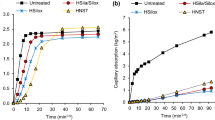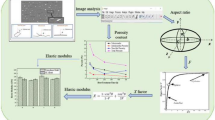Abstract
Thermal insulation properties of coatings based on selected functional filler materials are investigated. The underlying physics, thermal conductivity of a heterogeneous two-component coating, and porosity and thermal conductivity of hollow spheres (HS) are quantified and a mathematical model for a thermal insulation coating developed. Data from a previous experimental investigation with hollow glass sphere-based epoxy and acrylic coatings were used for model validation. Simulations of thermal conductivities were in good agreement with experimental data. Using the model, a parameter study was also conducted exploring the effects of the following parameters: pigment (hollow spheres) volume concentration (PVC), average sphere size or sphere size distribution, thermal conductivities of binder and sphere wall material, and sphere wall thickness. All the parameters affected the thermal conductivity of an epoxy coating, but simulations revealed that the most important parameters are the PVC, the sphere wall thickness, and the sphere wall material. The model can be used, qualitatively, to get an indication of the effect of important model parameters on the thermal conductivity of an HS-based coating and thereby be used as a specification tool or as a help in the planning of relevant experiments to conduct. Further work with the model must involve additional experiments to secure a general verification of important underlying model assumptions.












Similar content being viewed by others
Abbreviations
- A :
-
Outer surface area of pipe (m2)
- C :
-
Radiation number, 5.72 × 10−8 W/(m2·K4)
- d p :
-
Hollow sphere diameter (m)
- d po :
-
Base case diameter of hollow glass sphere (m)
- D v,10% :
-
Hollow sphere diameter below which 10% of the total particle volume is present (m)
- D v,50% :
-
Hollow sphere diameter below which 50% of the total particle volume is present (m)
- D v,90% :
-
Hollow sphere diameter below which 90% of the total particle volume is present (m)
- D y :
-
Outer diameter of steel pipe (m)
- FC :
-
Forced convection
- h y :
-
Heat transfer coefficient from coating surface to surrounding fluid [W/(m2·K)]
- HS :
-
Hollow spheres
- HGS :
-
Hollow glass spheres
- k Air :
-
Thermal conductivity of air [mW/(m·K)]
- k B :
-
Thermal conductivity of binder matrix in coating [mW/(m·K)]
- \( k_{\text{B}}^{ \circ } \) :
-
Base case thermal conductivity of binder matrix in coating [mW/(m·K)]
- k BSG :
-
Thermal conductivity of borosilicate glass [mW/(m·K)]
- k C :
-
Thermal conductivity of insulation coating [mW/(m·K)]
- k G :
-
Thermal conductivity of wall material of hollow spheres [mW/(m·K)]
- \( k_{\text{G}}^{ \circ } \) :
-
Base case thermal conductivity of wall material of hollow spheres [mW/(m·K)]
- k HS :
-
Thermal conductivity of hollow spheres [mW/(m·K)]
- k HGS :
-
Thermal conductivity of hollow glass spheres [mW/(m·K)]
- N :
-
Number of particle classes in hollow sphere size distribution
- NC :
-
Natural convection
- q :
-
Heat flux (W/m2)
- PVC:
-
Pigment (hollow spheres) volume concentration (vol%)
- T o :
-
Fluid (gas or liquid) temperature (K)
- T steel :
-
Steel wall temperature (K)
- T surface :
-
(Outer) coating surface temperature (K)
- V Air :
-
Unit volume of air (m3)
- v B :
-
Volume fraction of binder in coating
- V B :
-
Volume of binder (m3)
- V BSG :
-
Volume of borosilicate glass (m3)
- V HGS :
-
Volume of hollow glass spheres (m3)
- V i :
-
Volume fraction of particles present in a given size interval
- V HS :
-
Volume fraction of hollow spheres in coating
- ε :
-
Porosity of hollow spheres
- ε E :
-
Emissivity of epoxy coating
- δ :
-
Hollow sphere wall thickness (m)
- Δq :
-
Reduction in heat loss (%)
- ρ Air :
-
Density of air (kg/m3)
- ρ BGS :
-
Density of borosilicate glass (kg/m3)
- ρ HGS :
-
True density of hollow glass spheres (kg/m3)
References
Achar, S, Procopio, J, Developments in Waterborne Thermal Insulation Coatings, pp. 48–59. JPCL, March issue (2013)
Pidhurney, J, Pescatore, PF, “Aerogel for Highly Thermally Insulative Coatings.” JCT CoatingsTech, 9 (June issue), 46–48 (2012)
Sørensen, PA, Kiil, S, Weinell, CE, Dam-Johansen, K, “Anticorrosive Coatings—A Review.” JCT Res., 6 (2) 135–177 (2009)
Dow Hyperlast, Silver Anniversary, Brochure downloaded from Dow.com
Hamilton, RL, Crosser, OK, “Thermal Conductivity of Heterogeneous Two-Component Systems.” Ind. Eng. Chem. Fundam., 1 (3) 187–191 (1962)
Francl, J, Kingery, WD, “Thermal Conductivity: XI, Experimental Investigation of Effect of Porosity on Thermal Conductivity.” J. Am. Chem. Soc. Part II, 37 (2) 99–107 (1954)
Szekely, J, Ewans, W, Sohn, HY, Gas-Solid Reactions, Chapter 1–2, Academic Press, London (1976)
Lima, MMRA, Monteiro, RCC, Graca, MPF, Silva, MGF, “Structural, Electrical and Thermal Properties of Borosilicate Glass-Alumina Composites.” J. Alloys Compd., 538 66–72 (2012)
www.camglassblowing.co.uk, accessed May 2013
Kiil, S, “Quantification of Simultaneous Solvent Evaporation and Chemical Curing of Thermoset Coatings.” J. Coat. Technol. Res., 7 (5) 569–586 (2010)
3M Glass bubbles: K Series and S Series, Product Information, United States home page of 3M, http://solutions.3m.com/wps/portal/3M/en_US/Glass/Bubbles/Products/, April 2013
Kiil, S, “Drying of Latex Films and Coatings: Reconsidering the Fundamental Mechanisms.” Prog. Org. Coat., 57 236–250 (2006)
Patton, TC, Paint Flow and Pigment Dispersion, 2nd ed. Wiley, New York (1979)
Incropera, F, De Witt, D, Introduction to Heat Transfer, 2nd ed. Wiley, New York (1990)
Clement, KH, Fangel, P, Jensen, AD, Thomsen, K, Kemiske Enhedsoperationer (in Danish), 5th ed. Polyteknisk Forlag, ISBN 87-502-0941-8, 2004
Kiil, S, “Model-based analysis of photoinitiated coating degradation under artificial exposure conditions.” J. Coat. Technol. Res., 9 (4) 375–398 (2012) (open access article).
Webster, JG (ed.), The Measurement, Instrumentation, and Sensors: Handbook, co-published by CRC Press and Springer, New York, 1999
Clement, K, Jensen, AD, Thomsen, K, Fanger, P, Kemiske Enhedsoperationer (in Danish), 5th ed., Polyteknisk Forlag, Lyngby, 2004
Shokralla, SA, Al-Muaikel, NS, “Thermal Properties of Epoxy (DGEBA)/Phenolic Resin (Novolac) Blends.” Arabian J. Sci. Eng., 35 (1B), 9–14 (2010)
Mark, J (ed.), Physical Properties of Polymers Handbook, 2nd ed., Springer, New York, 2007
Wicks, ZW, Jones, FN, Pappas, SP, Wicks, DA, Organic Coatings—Science and Technology, 3rd ed. Wiley, New York (2007)
Acknowledgments
The author wishes to thank M.Sc. Stud. Maja Lind-Nielsen for conducting the SEM measurements at DTU CEN. Financial support by The Hempel Foundation is gratefully acknowledged.
Author information
Authors and Affiliations
Corresponding author
Rights and permissions
About this article
Cite this article
Kiil, S. Model-based analysis of thermal insulation coatings. J Coat Technol Res 11, 495–507 (2014). https://doi.org/10.1007/s11998-013-9562-7
Published:
Issue Date:
DOI: https://doi.org/10.1007/s11998-013-9562-7




